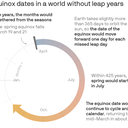Here's the science and math behind leap day

We have an extra day in 2024: Thursday is Feb. 29, also known as leap day.
Why it matters: If we didn't have leap days, then the months and the seasons would stop lining up the same way every year.
- "The days of our years would start slipping and … our winters would become summers and our summers would become winters and everything would get messed up," planetary geologist Bob Craddock tells Axios.
Zoom in: Spring would shift to starting in July within 425 years.
How it works: We have a leap year with an extra leap day to "catch up" to the length of time the Earth takes to orbit the sun, Craddock says.
- It doesn't take exactly 365 days for the Earth to complete an orbit — it takes almost six hours more than that.
Yes, but: An every-four-years leap year does not perfectly account for the extra time it takes the Earth to complete an orbit.
- That's why there's another rule about adding days: If a year is divisible by 100 and not divisible by 400, then we skip leap year.
- That means that we had a leap year in 2000, but the next leap year we skip is 2100.
Between the lines: Calling a year with 366 days a "leap" year may seem counterintuitive, but Craddock says there is a jump going on with days of the week.
- If your birthday was on a Monday one year, and then the next year is a leap year, it'll move to a Wednesday the next year. It "leaps" over Tuesday.
- But outside of leap years, if your birthday is on a Monday one year, it'll be on Tuesday the next year. The event otherwise moves to the next day of the week.
More calendar math: Why Lunar New Year and Jewish holidays fall on different dates